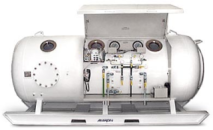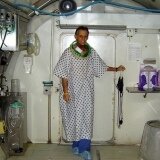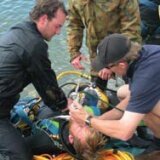Hyperbaric Medicine and Undersea

Hyperbaric Medicine is a therapy and a science of restoring or preserving health using the oxygen under increased pressure (hyper = increased, baric = pressure) 57.
The history of Hyperbaric Oxygen Therapy is closely linked to the history of diving.
Early breath-hold divers, dating back more than 5000 years, were confined to work in waters less than 30 meters (100 feet) deep, performing tasks such as harvesting food, coral, sponges and pearl as well as the odd ship salvage, a task which still captivates the attention and imagination of most modern age divers.
These first divers were limited to the shallow waters. Diving pioneers had discovered the eardrum-rupturing effects of increasing underwater pressure. Those attempting to venture deeper in diving bells also quickly learned about the well-known medical condition associated with the diving: Decompression Sickness or DCS - a sometimes fatal condition resulting from the formation of nitrogen bubbles in the blood and tissues, because of too rapid decompression, seen especially in deep-sea divers ascending rapidly from a dive.

It was not until the middle of the nineteenth century that the effectiveness of curing Decompression Sickness with Hyperbaric Chamber recompression was discovered. Although recompression in air was utilized first, hyperbaric oxygen (HBO2) is now used, and this is the principal connection between hyperbaric medicine and the other forms of hyperbaric medicine.
Medical practitioners made first attempts to heal by varying atmospheric pressure as early as the 1600s.
Physical Basis Of Hyperbaric Medicine
The main interactive elements involved in hyperbaric therapy are liquids and gases: the body fluids like blood, plasma, lymph, cerebrospinal fluid, and the oxygen.
Therefore the primary physical mechanism of healing with Hyperbaric Oxygen is governed by each one of several general gas laws associated with the names of famous scientists - Boyle, Charles, Dalton, Gay-Lussac and Henry. Summarizing interrelations between gases, liquids, temperature and pressure - these laws are explaining the physical nature behind the effects of Hyperbaric Medicine.
Robert Boyle
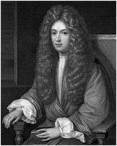
Robert Boyle (1627 - 1691), an Irish Natural Philosopher, chemist, physicist, and inventor, famous for his work in physics and chemistry is regarded today as the first modern chemist.
In 1660 Boyle published his New Experiments Physio-Mechanical, Touching the Spring of Air and its Effects containing his famous law describing the relation between pressure and gas volume.
Boyle's law...
for a given amount of a gas kept at a constant temperature, pressure and volume are inversely proportional - when one increases, the other decreases
As pressure increases, the gas volume is reduced; as pressure is reduced, the gas volume increases. This law, especially when combined with the work of Gay-Lussac and Charles (the details below ) produce the General Gas Law invaluable to diving and recompression chamber operations: P1V1/T1= P2V2/T2

The below 1660 text was the result of three years of experiments conducted with the help of scientist Robert Hooke.
![]()
Using an air pump designed by Hooke, Boyle was able to discover a series of important facts, such as sound not travelling in a vacuum, a flame requiring air and investigating the "elastic properties of air".
Boyle also first described the effects of Decompression Illness when in 1670 he used the vacuum pump to decompress a snake (undoubtedly somewhat rapidly) and reported: "I once observed a viper furiously tortured in our exhausted receiver that had manifestly a conspicuous bubble moving to and fro in the waterish humour of one of its eyes."
Boyle's law helps to explain what happens when a bottle of warm soda is opened. Under pressure, a large volume of carbon dioxide (which gives soda its fizz) dissolves in the beverage in accordance with Henry's law. When the cap is removed, the pressure on the liquid is relieved and the fluid cannot hold as much gas in solution. The gas forced out of solution rapidly forms bubbles. During deep-sea diving, inert gas breathed at relatively high pressure dissolves and accumulates in body tissues. As the diver returns to the surface, the gas may form bubbles that interfere with normal physiological processes. For example, blood circulation can disrupted by bubbles that clog small blood vessels, and pain can result when bubbles attempt to expand within the closed spaces of joints. The condition in which this occurs is called decompression sickness or "the bends."
Jacques Alexandre Cesar Charles
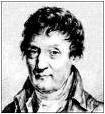
Jacques Alexandre Cesar Charles (1746 -1823) was a French inventor, scientist, mathematician, and balloonist.
Around 1787 Charles did an experiment where he filled 5 balloons to the same volume with different gases. He then raised the temperature of the balloons to 80oC and noticed that they all increased in volume by the same amount.
This unpublished experiment was later referenced by Gay-Lussac in 1802 when he published a paper on the precise relationship between the volume and temperature of a gas, which Gay-Lussac named "Charles' Law" in honor of Jacques Charles' original experiment, and also because he didn't want to confuse people by having two laws named after himself.
Charles' law
under constant pressure, an ideal gas' volume is proportional to its absolute temperature
The volume of a gas at constant pressure increases linearly with the absolute temperature of the gas. The formula he created was V1/T1=V2/T2.
John Dalton
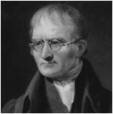
John Dalton (1766 -1844) was an English chemist, meteorologist and physicist. He is best known for his pioneering work in the development of modern atomic theory, and his research into color blindness sometimes referred to as Daltonism, in his honor. He enunciated Gay-Lussac's law or J.A.C. Charles's law, published in 1802 by Joseph Louis Gay-Lussac. In the two or three years following the reading of these essays, Dalton published several papers on similar topics, that on the absorption of gases by water and other liquids (1803), containing his law of partial pressures now known as Dalton's law.

In chemistry and physics, Dalton's law often called Dalton's law of partial pressures.
Dalton's law...
"...the total pressure exerted by a gaseous mixture is equal to the sum of the partial pressures of each individual component in a gas mixture"
P_{total} = sum_{i=1} ^ n {p_i}
- or

This empirical law was observed by John Dalton in 1801 and is related to the ideal gas laws.
William Henry
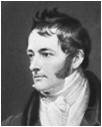
William Henry (1775-1836) was an English chemist. He began to study medicine in 1795 at Edinburgh, made his doctor's degree in 1807, but had to interrupt his practice as a physician because of ill-health. He devoted the rest of his life mainly to research of chemistry, especially gases.
His studies dealt with gas analysis, fire-damp, illuminating gas, the composition of hydrochloric acid and of ammonia, urinary and other morbid concretions, the disinfecting powers of heat and other areas.
One of his best-known papers describes experiments on the quantity of gases absorbed by water at different temperatures and under different pressures. The results of his research are known today as Henry's law.
Henry's law
the amount of any given gas that will dissolve in a liquid at a given temperature is directly proportional to the partial pressure of that gas
Charles's Law, Boyle's law, and Gay-Lussac's Law form the combined gas law.
Domicilium, The First Hyperbaric Chamber
The most recognized birth date of hyperbaric medicine actually precedes the discovery of oxygen 58.
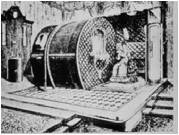
It would have been with British Clergyman Henshaw in 1662 when he built his "Domicilium", driven by organ bellows, with valves to control the flow of air.119 This sealed chamber was used to create both hyper (above normal) and hypo (below normal) - baric conditions.
Despite lacking any scientific basis for his theories, Henshaw believed that patients suffering from acute conditions would benefit from increased air pressure, whilst those suffering more chronic ailments would profit from a more rarefied environment, "In times of good health this domicilium is proposed as a good expedient to help digestion, to promote insensible respiration, to facilitate breathing and expectoration and consequently, of excellent use for prevention of most affections of the lungs".
At this stage in history, air had yet to be broken down into its constituent gases, therefore, Henshaw's pioneering patients were only exposed to increases of pressure (such that can be achieved with organ bellows) without the other vital ingredient the oxygen which was not discovered yet until 1773 by Carl Wilhelm Scheele, and the term oxygen was not coined until 1777 by Antoine Lavoisier.
More than a century after Henshaw, the Dutch Academy of Sciences sponsored a prize in 1782 and subsequent years, for the design of an apparatus to study the effects of higher pressures in biology. There were no contenders, nor any recipients of the prize. It wasnt until the 1830s when the next major advancements in Hyperbaric Medicine would occur.
Hyperbaric Medicine In 19th Century
In the 1830's, France led the new fashion in Hyperbaric Medicine. Hyperbaric chamber exposures of between 2 and 4 ATA (e.g. atmospheres absolute) were stated to increase the circulation to the internal organs, improve the cerebral blood flow, and produce a feeling of well being.
Junod (1834) first made these observations, and they were taken up avidly by his colleagues, Tabarie and Pravaz. In 1837, Pravaz built a large hyperbaric chamber using it to treat a variety of ailments. The chambers were promoted and used specifically for pulmonary diseases, including tuberculosis, laryngitis, tracheitis and pertussis, as well as apparently unrelated diseases such as deafness, cholera, rickets, menorrhagia and conjunctivitis.
In 1845, Triger wrote about symptoms in coal miners consistent with decompression sickness. 62 Compressed air was used to force water from the tunnels. Like Boyle's snake, the miners apparently suffered no ill effects while under pressure. However, muscular pains and cramps occurred after they left the pressurized regions of the mine. In 1854, Pol and Watelle wrote that decompression was necessary for symptoms to develop and - perhaps most important - that recompression reduced symptoms. 63
The first hyperbaric chamber on the North American continent was built in 1860 in Oshawa, Ontario, Canada. The first such chamber in the United States was built by Corning a year later in New York to treat 'nervous and related disorders'. But just as the United States began its journey into hyperbaric medicine, hyperbaric chambers were available in nearly all major European cities.
In 1876, Bert reported that nitrogen bubbles formed in tissue during rapid decompression. 64 Nitrogen was thus implicated in the "Grecian bend," a term articulated by workers constructing the piers of the Brooklyn Bridge. The bent posture of afflicted individuals approximated the Grecian bend, a fashionable posture assumed by women of the period. Decompression sickness later became known as "the bends."
Workers constructing the tunnel beneath the Hudson River were also harmed by compressed air. Approximately one quarter of them apparently died from decompression sickness. When Moir treated the affected workers with recompression and relatively slow decompression, the death rate dropped dramatically.65 This worked because pressure forced the bubbles to re-dissolve and gradual reduction in pressure permitted nitrogen to emerge in bubbles small enough to circulate to the lungs, which disposed of them through exhalation.
Fontaine (1877) developed the first mobile hyperbaric operating theatre and by this time hyperbaric chambers were available in all major European cities. 59, 120 Interestingly, there was no general rationale for Hyperbaric Medicine and as a result, prescriptions varied from one physician to another. In those days, no methods were available to estimate the partial pressure of oxygen in blood, which at 2 ATA of air is about double that at sea level. In comparison, if pure oxygen is breathed at 2 ATA, the partial pressure of oxygen in the arterial blood is twelve times higher than normal.
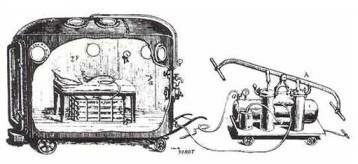
The chamber was recommended to facilitate the reduction of hernia, and for patients with asthma, emphysema, chronic bronchitis and anemia.59 Twenty-seven operations were performed within a 3 month period in this chamber. Success was so great that a large hyperbaric surgical amphitheatre which would hold 300 people was planned, although never actually came into being. Fontaine had an accident whilst at the Pneumatic Institute which resulted in his death, the first physician martyr to Hyperbaric Medicine.
Williams, in the British Medical Journal of 1885, made a comment, which would be thought by many to be applicable today: "The use of atmospheric air under different degrees of atmospheric pressure, in the treatment of disease, is one of the most important advances in modern medicine and when we consider the simplicity of the agent, the exact methods by which it may be applied, and the precision with which it can be regulated to the requirements of each individual, we are astonished that in England this method of treatment has been so little used".
Hyperbaric Medicine In 20th Century
In 1907 John Scott Haldane (1860 - 1936), a Scottish physiologist, made a decompression apparatus to help make deep-sea divers safer and produced the first decompression tables after extensive experiments with animals.

Dr. Haldane is famous for his numerous experiments and researches of the nature of gases and respiration, which led to some important discoveries.
His decompression tables were first used by the British Royal Navy to prevent and treat decompression sickness in deep-sea divers.
In 1912 the United States Navy had tested and further developed Haldane's decompression tables, which resulted in the first United States Navy Diving Manual. In 1927, the Experimental Diving Unit developed the US Navy Air Decompression Tables which have become the accepted world standard for diving with compressed air.
The Enthusiasm Of Dr. Cunningham...
Hyperbaric Chamber that received the most publicity and was the most actively used was that of Dr. Cunningham in Kansas City during the 1920's. Cunningham used his chamber to treat the victims of the Spanish influenza epidemic that swept across the USA during the closing days of the First World War. 60
Cunningham had observed that mortality from this disease was higher in areas of higher elevation, and he reasoned that a barometric factor was therefore involved. He claimed to have achieved remarkable improvement in patients who were cyanotic and comatose. One night however, a mechanical failure resulted in a complete loss of compression and all his patients died. This tragedy was a sobering lesson but ultimately did not deter Dr Cunningham. His enthusiasm for hyperbaric air continued, and he started to treat diseases such as syphilis, hypertension, diabetes mellitus, and cancer. His reasoning was based on the assumption that anaerobic infections play a role in the etiology of all such diseases.
In 1928 in Cleveland, Mr. Timkin, an appreciative patient whose uremic state was resolved after receiving hyperbaric therapies, constructed for Cunningham an enormous 60-ft tall, 64 feet in diameter, 6-story hyperbaric hospital that looked like a steel sphere. 61, 120

Each floor had 12 bedrooms with all the amenities of a good hotel. Conditions such as hypertension, diabetes, syphilis, and cancer were treated here until 1930, when the local medical society closed the hyperbaric hospital for lack of scientific evidence or merit.
Dr. Cunningham was repeatedly requested by the Bureau of Investigations of the American Medical Association (AMA) to document his claims regarding the effectiveness of Hyperbaric Medicine.
Apart from a short article in 1927, Cunningham made no efforts to describe or discuss his technique in medical literature. He was eventually censured by the AMA in 1928 in a report that stated: "Under the circumstances, it is not to be wondered that the Medical Profession looks askance at the 'tank treatment' and intimates that it seems tinctured much more strongly with economics than with scientific medicine. It is the mark of the scientist that he is ready to make available the evidence on which his claims are based."
Dr. Cunningham was given repeated opportunities to present such evidence but never did so. The Cunningham chamber was dismantled for scrap in 1937, which brought to a temporary end the era of Hyperbaric Oxygen Therapy for medical disorders.
Drager, who in 1917 devised a system for treating diving accidents, first realized the potential benefits of using oxygen under pressure for the treatment of decompression sickness.
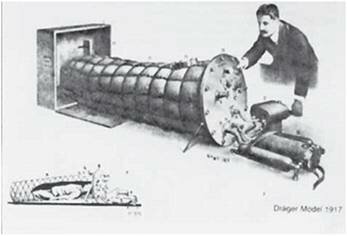
For some unknown reason, however, Drager's system never went into production. It was not until 1937 the very year that Cunningham's "air chamber" hotel was demolished that Behnke and Shaw actually used hyperbaric oxygen for the treatment of decompression sickness.
A flurry of interest in therapeutic hyperbaric medicine was fostered by Dr I. Boerema, who, while in Amsterdam in 1956, reported hyperbaric oxygen (HBO) as an aid in cardiopulmonary surgery, particularly for congenital conditions such as tetralogy of Fallot, transposition of great vessels, and pulmonic stenosis.66
A colleague of Boerema's, W. H. Brummelkamp, also interested in hyperbaric medicine, discovered in 1959 (and subsequently published in 1961) that anaerobic infections were inhibited by hyperbaric therapy. 67 Meanwhile, Boerema had published an article, "Life without blood," a report of fatally anemic pigs treated successfully with volume expansion and pressurised hyperoxygenation.123 Boerema often is credited as the father of modern-day hyperbaric medicine.
In 1962, Smith and Sharp reported the enormous benefits of HBO in carbon monoxide poisoning.68 International interest thus was rekindled, and HBO therapy was thrust into the modern era. Hyperbaric units subsequently were built at Duke University, New York Mount Sinai Hospital, Presbyterian Hospital and Edgeworth Hospital in Chicago, Good Samaritan in Los Angeles, St. Barnaby Hospital in New Jersey, Harvard Children's Hospital, and St. Luke's Hospital in Milwaukee. Further chambers were installed in numerous international sites.69
The benefits of Hyperbaric Oxygen Therapy (HBOT) subsequently were observed for split-thickness skin graft acceptance, flap survival and salvage, wound re-epithelization, and acute thermal burns. These studies lent credibility to the therapeutic employment of HBO therapy. This fostered the establishment of organized scientific congresses and societies such as the International Congress on Hyperbaric Oxygen and the Undersea Medical Society.
Inappropriate Use Of Hyperbaric Medicine
Unfortunately, as the availability of hyperbaric medicine chambers increased, the indiscriminate and inappropriate use of the chamber for a variety of medical conditions by practitioners searching for a "cure-all" therapy resulted in a backlash from the scientific society, once again tarnishing the credibility of Hyperbaric Medicine.
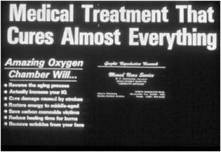
As a result, by the late 1970s, the Undersea Medical Society had formulated guidelines for the use of Hyperbaric Oxygen Therapy.
Hyperbaric Medicine Today
Researchers conducting wound-healing studies continued to try to take advantage of the angiogenic properties of increasing oxygen gradients resulting from hyperbaric therapy. Foot wounds from diabetes, radiation ulcers, and other ischemic wounds have been manipulated and successfully treated with Hyperbaric Medicine. Prospective blinded randomized trials and well-executed laboratory studies continue to further define the role of hyperbaric medicine in medical therapeutics.
The most recent and most significant documented advances with Hyperbaric Medicine have emerged with the utilization of high tech investigation including isotopic tracers with Magnetic Resonance Imaging (MRI) and Single Photon Emission Computed Tomography (SPECT).
MRI and SPECT performed as a pre and post hyperbaric evaluation have provided valuable insights into the mechanisms and actions of Hyperbaric Oxygen Therapy through oxygenation. Conditions that have previously been considered to have a poor prognosis, including brain injuries, stroke and neurological based conditions, have been greatly improved with Hyperbaric Medicine and continue, today, to be among the areas of research.
